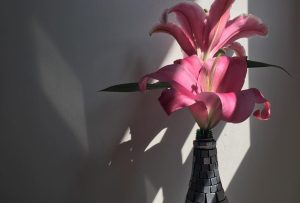We all know the benefits of having a potted plant or a bouquet of flowers in our home. Not only do they add accent to indoor spaces, but they can also add a relaxed, beautiful atmosphere to even the dreariest corners of one’s home.
Fresh flowers are the best as they are not only pretty, some of them smell good too. But what if you don’t have access to fresh flowers nor the time to buy and replace the wilted ones in your living room?

Well, artificial flowers can be pretty too. You can buy them from stores or if you want a more personal touch to it, why not DIY your own fabric flowers!
This sewing project is indeed a great option if you want to decorate your home with flowers. Compared to the real ones, fabric flowers can obviously last longer and don’t need to be watered at all. If you have scraps of pretty fabrics lying around, get your craft tools and start turning them into a vase of pretty fabric flowers!
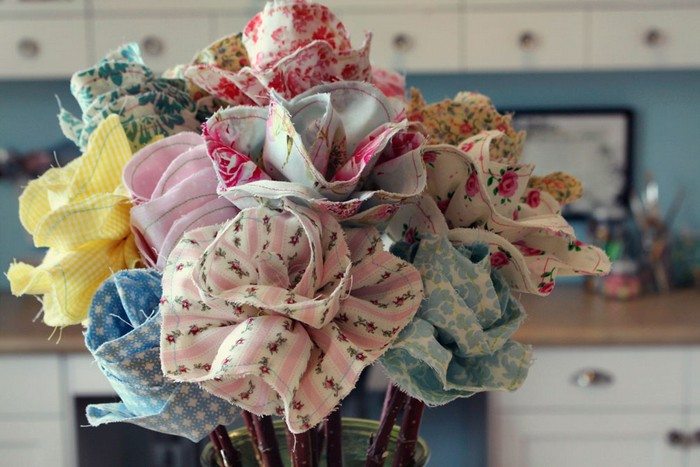
If you’re into sewing projects, then this should be very easy for you to make by just looking at the images we have on our album. But if you need a detailed step-by-step guide on how to make it, then head over to the link provided below our album.
You can put them in your living room, your kitchen or your bedside. You can even make them into a bouquet!
Can your home use some beautiful fabric flowers?
Making fabric flowers is a great way to add a personal touch to your home décor. They also make great gifts! Here are some charming DIY fabric flower designs to inspire you:
Charming DIY fabric flowers designs
Click on any image to start the lightbox display. Use your Esc key to close the lightbox.![]()
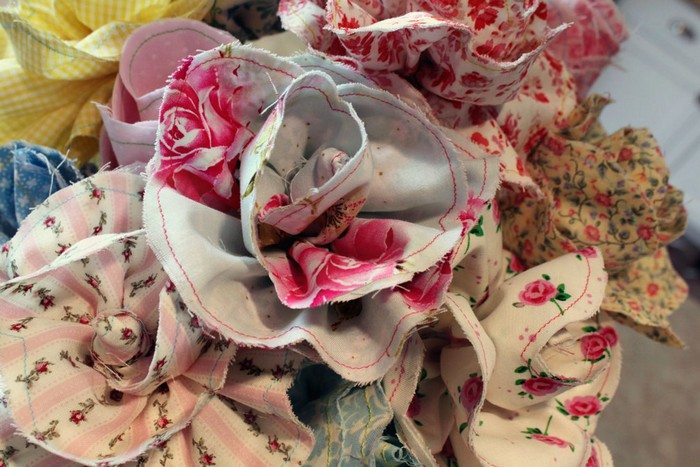



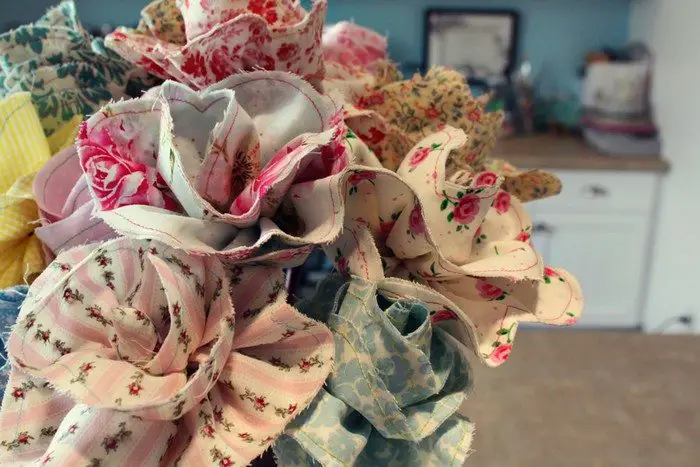


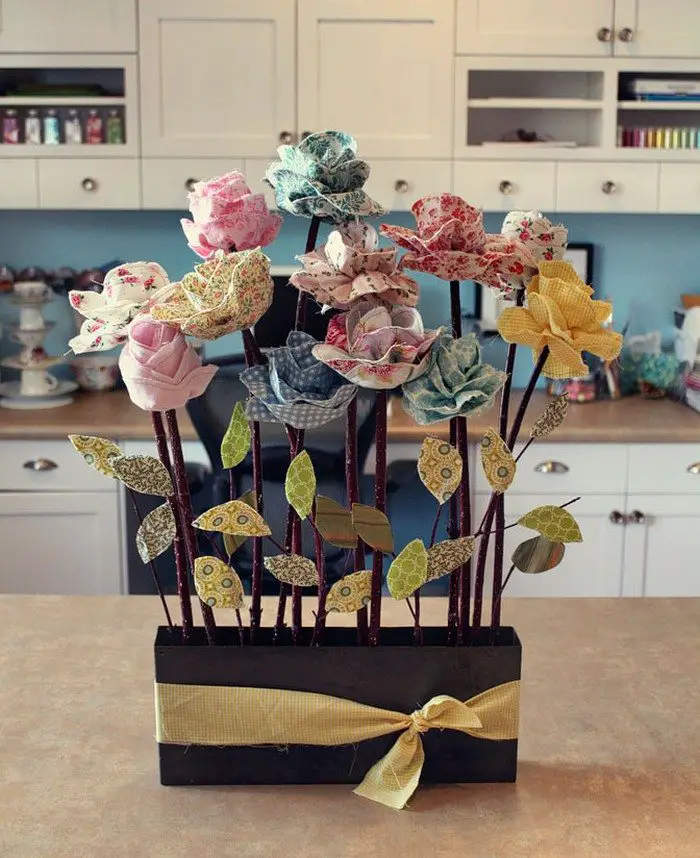
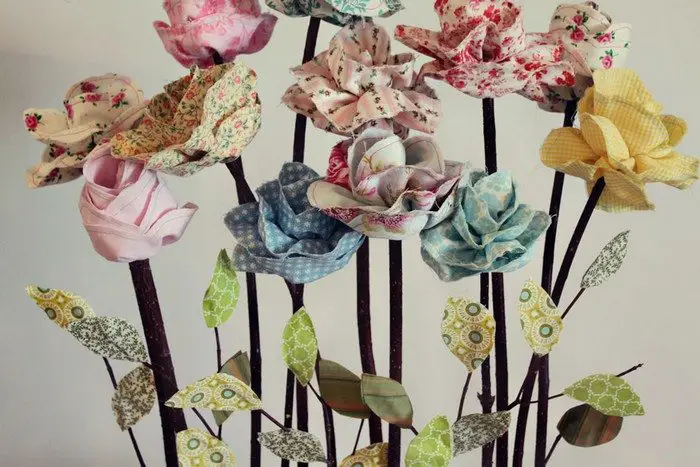

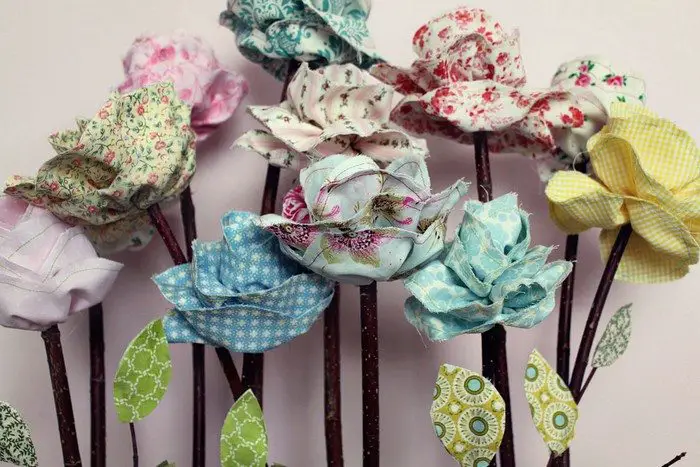
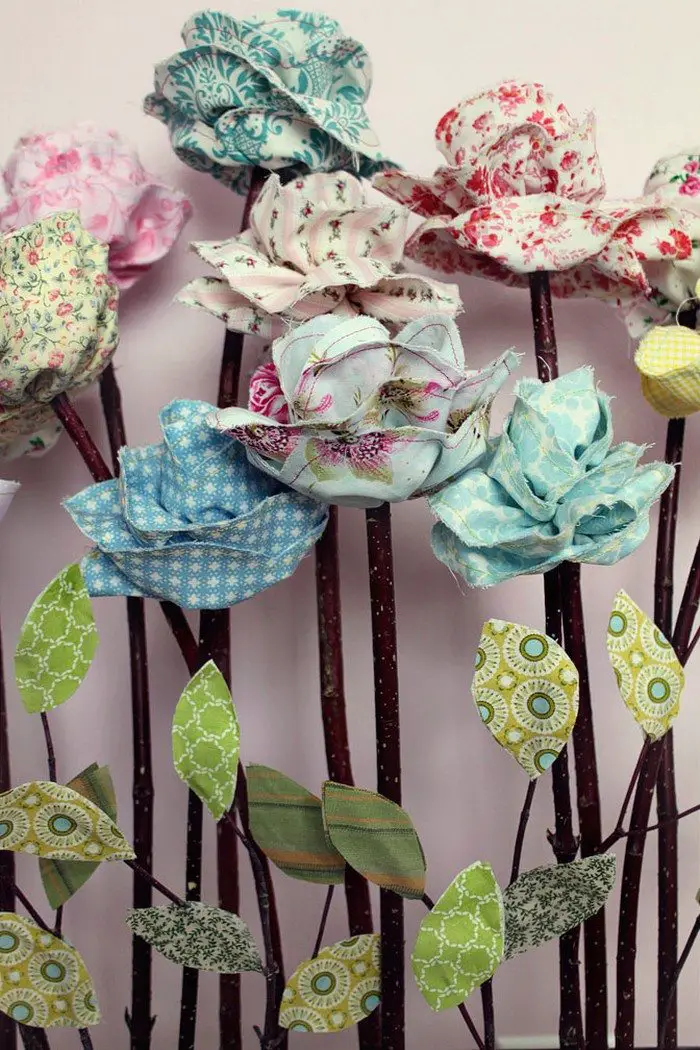
Contents
Making Fabric Flowers
This is a great project for anyone, regardless of your sewing skills. You’ll need a few supplies to get started:
Materials
- 5″ Fabric Strips
- Sticks (Stems)
Tools
- Sewing Machine and Other Sewing Tools
- Glue Gun
How to make DIY fabric flowers
With just a few simple supplies and some creativity, you can easily create beautiful blooms that will last forever. Plus, DIY fabric flowers make great gifts! Just follow these simples steps:
1. Prepare the fabric
Cut the fabric into strips. Approximately 5 inches each.
Fold the strips lengthwise and trim the edges.
Unfold the fabric and sew the line made by folding the fabric.
2. Make the petals
Each strip should be traced with a scallop design to make the petals. Make sure the sizes are equal. Using the guide markings, cut them with your scissors. You will need to leave at least four inches of tail at the end of each slit.
3. Sew the petals
Sew the scalloped edges made with a running stitch. Start at the base of the petal and work your way up, leaving a long tail of thread at the end. Once you’ve sewn all the way around, gently pull on the thread to gather the petal up, then knot the thread off to secure.
4. Start creating the flower figure
Using the tail, wrap it around the stick (this will be the stem). Continuously wrap the stick with the fabric until you make a circular-shaped flower – a rose.
5. Apply glue
To secure the shape of your flower, simply apply some glue to the flower and stem. You can use any type of glue, but we recommend a clear, quick-drying glue for the best results. Just a few drops will do the trick!
6. Add leaves
If you have any excess fabric, you can use it to make leaves and glue them to the stem. This will give your plant a more natural look, and it’s a great way to use up fabric scraps.
7. Make a bouquet
To make a bouquet, simply repeat this process for each petal, until you have a beautiful bouquet of fabric flowers!
Thanks to Snowy Bliss for this great project. You can get step-by-step instructions here…
Different Types of Fabric for Making Flowers
Creating fabric flowers is an enjoyable and creative way to add a personal touch to your home decor or fashion accessories. The choice of fabric can greatly influence the appearance and durability of the final product. Here are some popular types of fabric you can use to make stunning fabric flowers:
Silk
Silk is one of the most preferred materials for making high-quality fabric flowers due to its natural sheen and smooth texture. Silk flowers mimic the delicate and refined look of real flowers exceptionally well. This fabric is ideal for creating sophisticated wedding bouquets or luxurious decorative arrangements.
Cotton
Cotton is a versatile and easy-to-handle fabric, making it perfect for beginners experimenting with flowers. It comes in a vast array of colors and patterns, which allows for plenty of creativity and customization. Cotton flowers can bring a cheerful and casual vibe to any room or garment.
Felt
Felt is an excellent choice for crafting because it’s sturdy, doesn’t fray, and is thick enough to maintain the shape of the flower without needing additional support. Felt fabric flowers are great for projects that require more structure, like decorative pins or ornaments.
Organza
Organza is a light, sheer fabric that works beautifully for making ethereal and airy fabric flowers. The transparency of organza adds a layer of depth to the flowers, making them appear intricate and light. These flowers are perfect for elegant events and subtle home accents.
Each type of fabric offers unique benefits and can be used to create distinctive styles of fabric flowers, enhancing everything from fashion accessories to home décor. By choosing the right fabric, your fabric flowers can transform an ordinary item into a standout piece.
Coloring Techniques for Fabric Flowers
Fabric flowers offer a unique opportunity to customize decor and accessories with personal touches of color. Whether you’re looking to replicate the vibrant hues of nature or create something entirely original, the coloring techniques you choose can dramatically affect the aesthetics of your fabric flowers. Here are some effective methods to add color to your fabric flowers, enhancing their beauty and appeal.
Fabric Dyeing
One of the most popular methods for coloring fabric flowers is dyeing the fabric before crafting the flower. This technique allows for uniform coloration and can be done using various types of dyes depending on the fabric choice.
- Hot Water Dyeing: Ideal for fabrics like cotton and silk, this method involves dissolving dye in hot water and immersing the fabric until the desired shade is achieved. It’s great for achieving deep, saturated colors.
- Cold Water Dyeing: Suitable for delicate fabrics that may shrink or warp under heat, cold water dyeing uses fiber-reactive dyes that bond well at lower temperatures.
Painting
For those who want to add intricate details or multicolored patterns to their fabric flowers, painting is a fantastic option. Acrylic and fabric paints are commonly used, and techniques can vary from simple brush strokes to sophisticated methods like airbrushing.
- Brush Painting: Use a fine brush to apply paint directly to the fabric. This method is perfect for adding small details or gradients.
- Spray Painting: Spray paint or airbrushing offers a smooth, even coat of color and is ideal for larger batches of fabric flowers. It’s a quick way to cover a lot of material with a consistent layer of paint.
Stamping
Stamping is a fun and creative way to apply designs and patterns to fabric flowers. You can use pre-made stamps or create your own from everyday items.
- Direct Stamping: Press inked stamps directly onto the fabric to transfer designs. This method is great for creating repetitive patterns or adding logos and words.
- Resist Stamping: Apply a resist medium with a stamp before dyeing the fabric. The dye will not penetrate the resisted areas, leaving a unique pattern once the resist is washed away.
Tie-Dyeing
For a more psychedelic or varied effect, tie-dyeing can be used to create multi-colored fabric flowers with interesting patterns. This method involves tying sections of fabric and then dyeing them, which prevents the dye from reaching all parts of the fabric evenly.
- Spiral Tie-Dye: Twist the fabric into a spiral before tying, then apply different colors of dye for a swirling effect.
- Crumple Tie-Dye: Crumple the fabric into a ball and secure with rubber bands. Dye the fabric to create an organic, mottled color pattern.
Bleaching
For a reverse effect, bleaching out color from dyed fabric can create intriguing designs and can lighten areas for a distressed or vintage look.
- Patterned Bleaching: Apply bleach using stencils or sprays to remove color in specific patterns.
- Ombre Bleaching: Gradually apply bleach to create a faded effect, which is perfect for flowers intended to mimic natural variations in petal colors.
One can customize and mix any of these coloring processes to produce original and own flowers. Changing colors and techniques can not only improve the visual attractiveness of your fabric flowers but also allow you to stretch your creative limits. Colored fabric flowers can give any occasion a unique touch whether you’re making a handmade gift or decorating for a big event.
If you liked this project, you might also like to view the DIY Paper Flowers…



